March 2014
As we near the end of the month, new growth is beginning to show. We’ve had a mild winter here in northern England and recently a few warm early spring days. All of these conditions (despite the occasional hail storm) have added to the spurt of fresh green leaves. Tiny buds are also forming on the fruit trees as you can see with the morello cherry. The tree is fan-shaped, trained flat against the garden wall in between the quince and the damson plum.
However… (there is always a “however” in dealing with gardens) … because of the mild winter, slugs, snails and other undesirables have also thrived. I don’t like using chemicals, and try to use natural or environmentally friendly pest control methods. I’ve polished up the copper rings to ward off slimy creatures. Copper, a perfect conductor, apparently gives the critters a shock – kind of like an electric slug fence. This ring is protecting purple sage cuttings I made last year that have survived over winter.
As I look from my kitchen window, the rhubarb is almost ready to pick. It seemed like such a short time ago it was just beginning to show its first tentitive red stalks.
A few years ago, after losing endless battles with summer vegetables in this wet, snail infested corner of the world, I decided to switch to fruit, specifically fruit which grew easily in Britain – berries, berries and more berries. Yet, there are always reminders of those vegetable days – this early it is self seeded corn salad (lamb’s lettuce) sharing the bed with the gooseberries. I’ll let some of it run to seed (for future crops) and pick the remainder for a lovely early spring salad.
The gooseberries are just pushing out their new spring leaves on their long spiky branches and it won’t be long before the nascent buds form. This particular gooseberry was new last year, a small red dessert variety that made excellent jam.
The loganberries grow on long vines that grew from the base the previous year. The previous year’s vines, tied to an arch trellis, are just beginning to branch and the new shoots for next year’s crop are just breaking the soil.
Dried leaves and dead plants are being cleaned out of the herb garden – a small patch of land just outside the pantry door. It is a chaotically organised plot – plants stuck in when they were acquired, transplanted or spread to alter or fill in the picture. I like to think it has a beauty all its own, although it seems to be more bare brown earth at this time of year. The perennial herbs include chives, bay, various different types of thyme, rosemary (both upright and creeping), sages, marjoram, oreganos, lavender, fennel, winter savory, wild garlic, lovage, celery leaf and mints.
Cleaning up the herb garden also meant trimming the bay. When I first established this patch of land, I had a bay cutting, about six inches in height, with a good root system. I planted it next to the stone perimeter wall and now it is well over seven feet tall and needs radical trimming every spring, just as the flowering buds on the bush begin to form. This is when I stock up on my dried bay leaves for the pantry. Bay leaf is one of those herbs that is actually more fragrant, more potent once dried. I select the best of the leaves from the trimmed branches and dry them in a wide and shallow basket on the kitchen table, giving it a shake once a day so that the leaves are equally exposed to the air. When they begin to curl at the edges and lose a bit of their glossy color, they are dry enough to pack away in a glass container to use throughout the year.
I bring the garden into the kitchen with fruits and herbs, but just this past year, I actually managed to bring a bit of the kitchen to the garden. The old kitchen hearth excavated from the kitchen when we insulated and installed the reclaimed oak floor back in November (see my post Kitchen Archaeology) is now a path in front of the cage we created for the Autumn Bliss raspberries, allowing easy access for picking.
Our stone-built garden shed was created from the original Victorian outdoor toilet and coal store. Growing up one wall is the new blackberry vine, planted last year and hopefully ready for fruiting this year. We are great believers in recycling things, so the trellis is an old bit of fencing, like the ones used to create a raspberry cage you can see in the image above. But, mounted just above, is the salt glazed ceramic lion we purchased many years ago from the Errington Reay Pottery, located along Hadrian’s Wall in Northumberland. It guards the fruit garden, although it really isn’t isn’t an effective slug deterrent and I’m sure looting squirrels and birds simply ignore its fierce gaze.
Tasks to be done:
- Continue cleanup of beds, including the dreaded weeding.
- Clip the grape vine back while still in its dormant stage. I know I’m late in doing this!
- Rotate and aerate the compost (keeping a lookout for burrowing creatures).
- Harvest the rhubarb!
So, what’s happening in your edible garden?
A chronological listing of my Around My Edible Garden blog posts will be listed separate page under Diaries in the Menu bar.
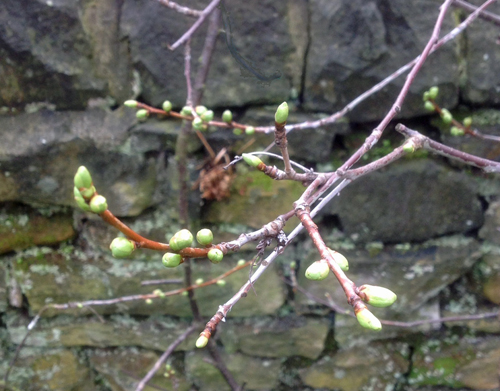
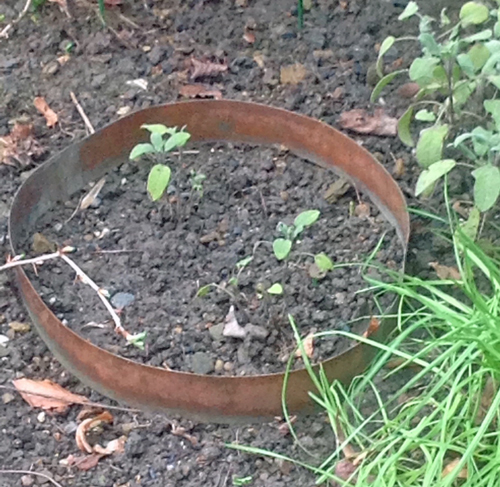

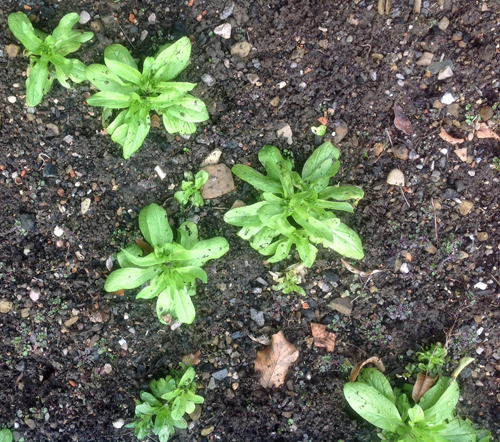
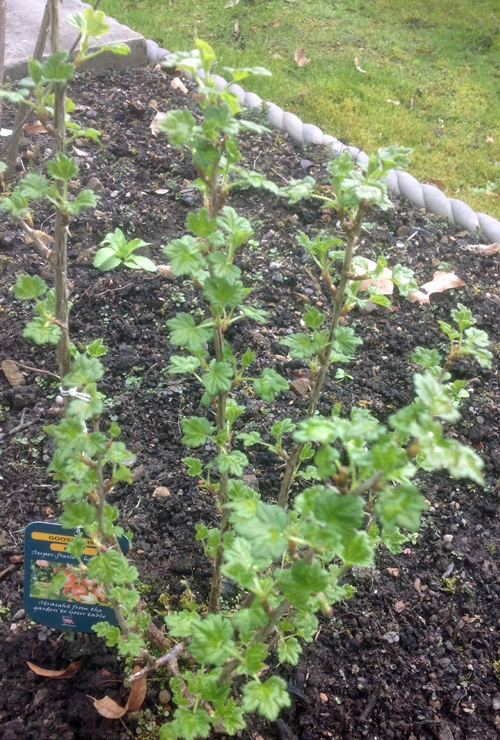

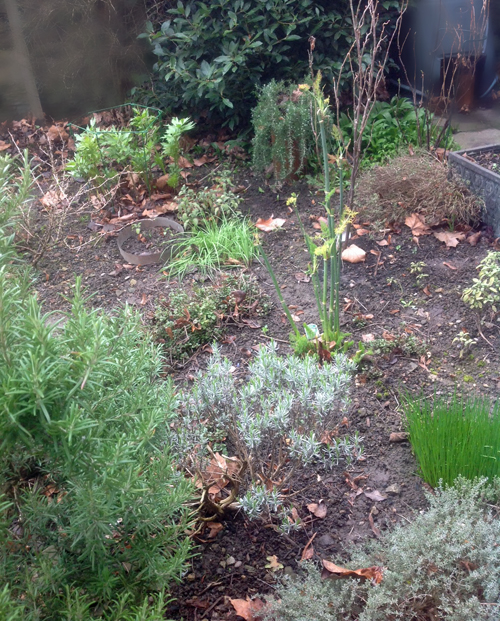

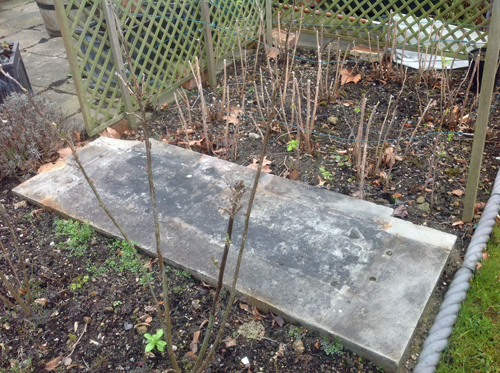

You are about to be extremely busy in your edible garden, with the beginning of Spring and new growth.The budding morello cherry photo is just lovely and the dry stone wall behind it – I am a little jealous of all these historic references in your garden. I didn’t know that about copper bands- will have to scour the junk shops for something like that.
LikeLike
Glad you saw the post. Seems odd that you’re busy with autumn tasks in your garden while I’m getting ready for spring. We live in an old Victorian neighbourhood – grey stone walls everywhere – so there is no escaping history. They make copper tape (very thin strips with sticky backs) for encircling the tops of pots since snails are very adept at climbing and then decimating whatever is growing in your pots. Copper bands really do work!
LikeLike
I must google it and see whether we have them here. I added a link to the end of my post. Thanks for joining in. Its a great way to keep garden records too.
LikeLike
[…] check out this delightful edible garden from Deborah ( My Kitchen Witch) in Sheffield, UK. Romantic stone walls, Morello cherries, herbs and bay trees, gooseberries […]
LikeLike
Wow! How wonderful ☺️ gardening and I don’t get on, I tried and failed to create a vegetable patch, although the stony soil didn’t really help!
LikeLike
Pots… You can have a great (and beautiful) herb garden with pots. They don’t require an awful lot of care and it is handy to simply nip outside and cut off a sprig of rosemary or a bunch of chives.
LikeLike
Good plan…maybe I’ll be brave enough to try again eventually…
LikeLike
Start simple. Grow things that are known to be hardy.
LikeLike
Okay 🙂 I’ll let you know when I have another go x
LikeLike
I’ve been attempting to grow fruit and vegetables in pots over the last few years and had varying results. Courgettes and cucumbers do great but tomatoes never ripen… I’ve got strawberries in hanging baskets this year. My rosemary and mint from last year are doing well still. I love eating my home grown veges! Though I am very envious of your garden! 🙂
LikeLike
I stopped growing tomatoes after years of trying – blight every time! I don’t think The UK (particularly the north) is conducive to growing tomatoes, peppers, aubergines etc. – all the Mediterranean type of plants I love. Hence, the move to fruit – gooseberries, raspberries, etc. I grow one of my loganberry vines in a large pot – against a wall with a trellis and also grow blueberries in large pots to control the acid soil conditions. Growing things in pots can be done! Love the idea of strawberries in a hanging basket!
LikeLike
I’m in the north of England too, most people I know who grow decent vegetables have greenhouses on allotments! I’ve managed to grow all sorts of beans and peas in pots too, but maybe your idea of fruits growing will be more productive!
LikeLike
So much promise for the warmer months ahead. Our bay tree was so large it had to be pulled down before it knocked over a building – lots of dried bay leaves that year and a good cutting to start another bush in a more sensible place. Looking forward to seeing the progress through the year.
LikeLike
Those bay trees grow like mad! I envy you your much larger plot of land. I’ve almost run out of space and am frantically trying to find a spot for another rhubarb – this time a completely red one. The flowers may have to go!
LikeLike
Stunning pictures, I love this time of year.
LikeLike
Yeah! Springtime. It’s the best that the British Isles has to offer in terms of weather.
LikeLike
So true xx
LikeLike
This is very inspiring. It’s all starting to happen over here in the Pacific Northwest USA too. Exciting! 🙂
LikeLike
I love the Pacific Northwest – great growing conditions there. Spring is always very exciting in the garden – that period of time when things are just awakening, before the onslaught of weeds and slugs!
LikeLike
I loved taking walk with you through your edible garden – cannot believe how much your bay tree has grown! Spring is such a wonderful season – thanks so much for sharing this with us x
LikeLike
Spring is the best season in Britain. When we lived in Wisconsin, spring was simply a blink between snow and mosquito season!
LikeLike
Very similar to Winnipeg – a big, messy thaw and then mosquitos and caterpillars…it’s still snowing there now – they’ve had terrible weather this winter.
LikeLike
Thanks for the wonderful post! And I had no idea copper could keep slugs at bay — good to know, if I ever have a garden again.
LikeLike
Glad you liked the post. I really don’t know what I would do without a garden – or at least a small plot of land to grow herbs. Copper works up to an extent, but it isn’t 100% slug-proof. First defences for the tender young plants.
LikeLike
I’m so jealous of your garden! 😉 Growing my own vegetables and fruit is something I have never put my mind into. I can only image how much work, time, perseverance and patience it may require. On the other hand, it must be very fulfilling and something to be extremely proud of.
Maybe one day …
LikeLike
It is a bit of work, but one of the reasons I switched to fruit trees and bushes is the fact that they require less maintenance than vegetables. The herbs are also mostly perennial and just need initial cleanup and clipping at times. It is, however, very satisfying!
LikeLike
I wish a kitchen garden like yours… I only have a terrace with aromatic herbs pots… But i hope one day to grow more in a bigger place! 🙂
LikeLike
A terrace is better than no garden at all! Think of all the sorts of things you can grow in pots. You’ve got the right idea – herbs are a must, even if you have to grow them on the kitchen windowsill. I hope you achieve your goal and get a larger place sometime.
LikeLike
[…] ← Around My Edible Garden […]
LikeLike